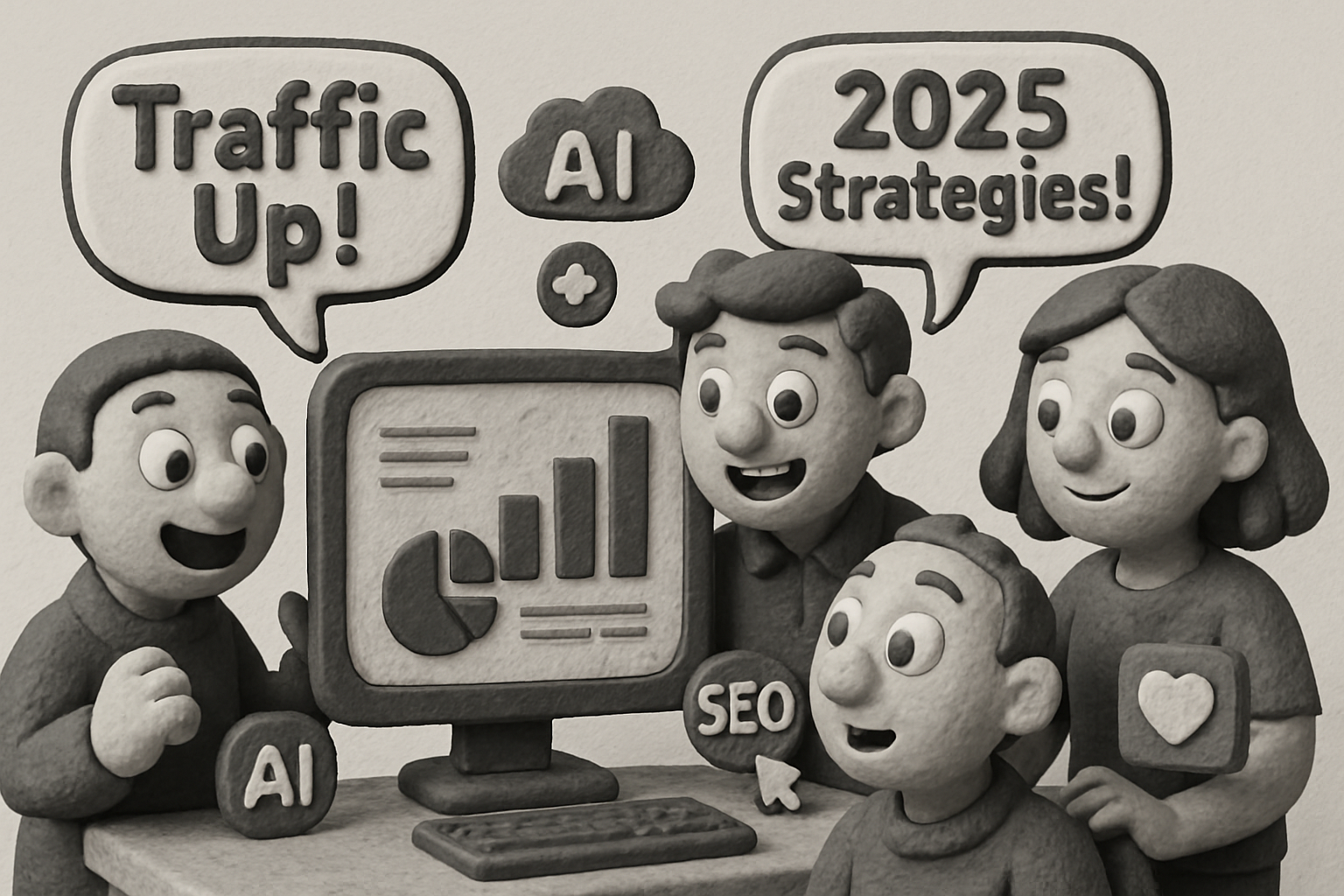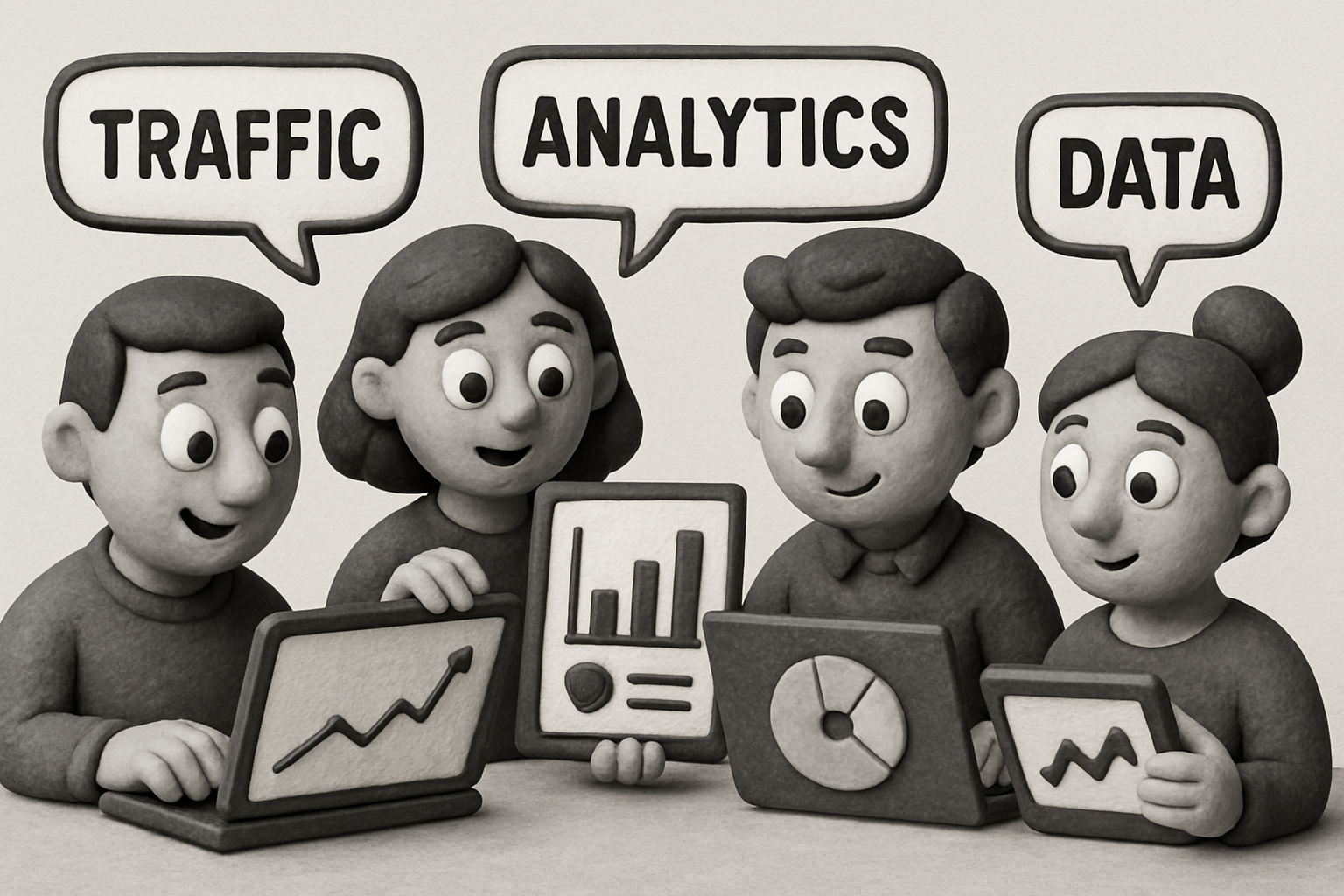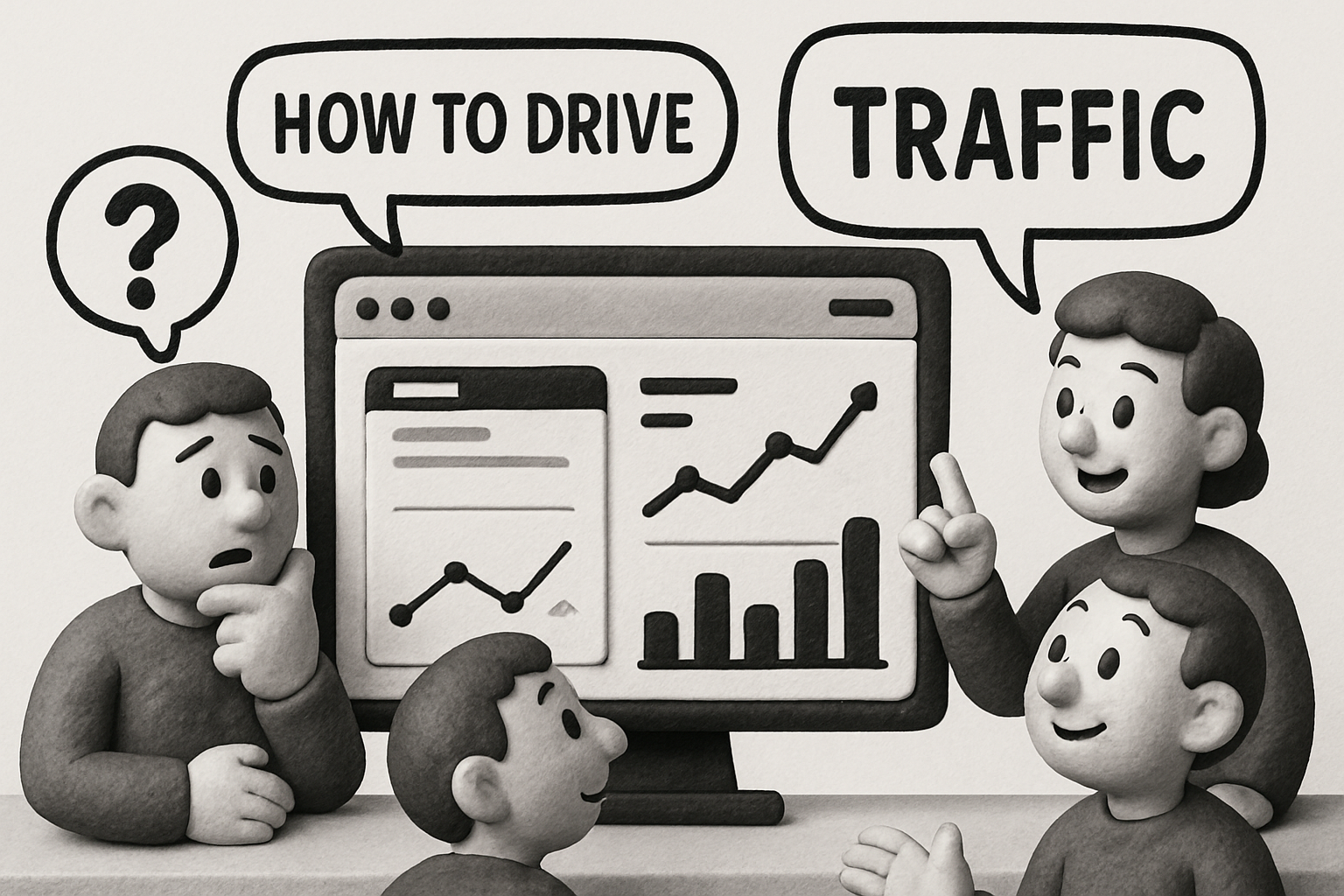Online competition is fiercer than ever in 2025. With digital trends shifting rapidly, brands are fighting for every bit of attention and visibility online.
Website traffic remains the lifeblood of business growth, fueling lead generation and building online authority. But here’s the catch—what worked yesterday to generate website traffic may fall flat today.
Outdated tactics are no longer effective. To thrive, businesses must embrace new, proven strategies that keep pace with the changing digital landscape.
In this article, you’ll discover 7 essential, up-to-date ways to generate website traffic in 2025. We’ll cover advanced SEO, content innovation, AI-powered tools, social media trends, and more—giving you the actionable insights needed to stay ahead.
The Changing Landscape of Website Traffic Generation in 2025
Adapting to the ever-evolving digital landscape is crucial if you want to generate website traffic in 2025. User expectations, search behaviors, and the very tools we use are shifting rapidly. Understanding these changes is the first step toward building a future-proof strategy.

Evolving User Behavior and Search Trends
User behavior is transforming how brands generate website traffic. Voice search and AI assistants have become everyday tools, driving a surge in conversational queries. Mobile-first browsing now dominates, with over 65% of all searches happening on smartphones.
Zero-click searches, where users get answers directly from the search results page, are on the rise. This means less traditional organic traffic but higher value for optimized, intent-driven content. Recent studies show users increasingly favor quick answers and multimedia formats. If you want to generate website traffic, you must align your content with these new search habits.
The Impact of AI and Automation on Traffic Strategies
AI is revolutionizing how marketers generate website traffic. Today’s AI tools automate keyword research, streamline content creation, and personalize user experiences at scale. Businesses are leveraging AI-driven platforms to create tailored landing pages and dynamic content feeds that boost engagement.
For example, 70% of digital marketers adopted AI technologies in 2024, leading to measurable gains in traffic and efficiency. Want to stay ahead? Explore AI and SEO strategies to see how automation can enhance your approach and generate website traffic in smarter, faster ways.
The Role of Social Platforms and Community-Driven Content
Social platforms are now powerful engines to generate website traffic, especially through niche communities. Spaces like Reddit, Discord, and Facebook Groups foster authentic interactions and drive targeted referrals. Micro-influencers and peer recommendations carry more weight than ever, shaping brand discovery and trust.
In 2024, referral traffic from social platforms grew by 35%, with community-driven content outperforming generic posts. Brands that engage directly with these micro-communities, encourage user-generated content, and build trust see a steady stream of high-quality visitors. To generate website traffic, focus on genuine participation and value-driven conversations.
Why Diversification is Essential for Sustainable Traffic
Relying on a single channel to generate website traffic is risky. Search and social algorithms can change overnight, causing sudden drops in visibility. For example, many sites saw traffic plummet after recent search updates, exposing the danger of a one-dimensional approach.
Diversification buffers against these risks. By combining SEO, social, email, partnerships, and emerging channels, you maximize your reach and protect your traffic flow. In 2025, businesses that generate website traffic from multiple sources are better positioned to weather digital storms and capture sustainable growth.
7 Essential Ways to Generate Website Traffic in 2025
Standing out online in 2025 means adopting the most current, effective strategies to generate website traffic. The digital landscape is evolving faster than ever—so let’s dive into the seven tactics that will drive sustainable, high-quality visits to your site this year.

1. Optimize for AI-Driven Search and Conversational Queries
AI-powered search engines like Google SGE and Bing Copilot are rewriting the rules for how people generate website traffic. These platforms understand natural language, context, and user intent more deeply than ever before.
To succeed, you must optimize for conversational queries. This means crafting content that answers real questions in a natural, human tone—think FAQs, how-tos, and in-depth guides. Schema markup is critical, helping search engines interpret your site’s structure and relevance.
Tips for AI-first optimization:
- Use schema for articles, FAQs, and products.
- Write content in a Q&A format to match voice search patterns.
- Focus on long-tail, intent-driven keywords.
Brands like recipe sites and travel blogs are thriving by embracing this approach, seeing significant boosts in featured snippets and voice assistant referrals. According to recent data, conversational search queries have grown by over 60% since 2023.
To generate website traffic in 2025, you must think like your users—and the AI engines that serve them.
2. Create Value-Driven, Interactive, and Multimedia Content
Static blog posts alone won’t help you generate website traffic at scale anymore. Audiences crave immersive, interactive experiences—think calculators, quizzes, polls, and assessment tools that offer real value.
Video and podcasts are also exploding in popularity. Short-form videos, explainer animations, and audio snippets help keep visitors engaged and encourage sharing. Embedding multimedia increases dwell time and signals quality to search engines.
Ideas for interactive content:
- Launch a quiz that recommends products or services.
- Embed calculators for ROI, savings, or personal assessments.
- Host live webinars or interactive tutorials.
Data shows that interactive content can generate website traffic up to 3x more effectively than static articles. Companies like BuzzFeed and HubSpot have achieved viral growth by prioritizing these formats.
When your content is both engaging and useful, visitors stick around—and bring others with them.
3. Leverage Social Media Micro-Communities and Emerging Platforms
To generate website traffic beyond traditional channels, tap into fast-growing social micro-communities. Platforms like Threads, Lemon8, and niche Discord servers are hotbeds for authentic engagement and referral traffic.
The key? Build trust by participating in conversations, not just promoting your links. Collaborate with micro-influencers who have deep relationships within their communities. User-generated content (UGC) campaigns—where fans share their experiences—can amplify your reach exponentially.
Effective strategies include:
- Joining and contributing to targeted Facebook Groups or subreddits.
- Partnering with niche Discord moderators for AMA sessions.
- Encouraging fans to create and share branded content.
In 2024, referral traffic from emerging social platforms grew by over 40%. Brands that generate website traffic from these sources enjoy more loyal, higher-converting audiences.
Don’t overlook these vibrant corners of the internet—they’re often where your future customers are already hanging out.
4. Implement Advanced SEO and Semantic Optimization
SEO in 2025 is all about depth, context, and trust. To generate website traffic consistently, you must embrace E-E-A-T (Experience, Expertise, Authoritativeness, Trustworthiness) and semantic SEO techniques.
This means organizing your content into topic clusters, optimizing for related entities, and ensuring your site’s internal linking structure is strong. Use structured data and answer broad and specific questions within your niche.
Actionable steps:
- Build content silos around core topics.
- Link related articles to signal topical authority.
- Optimize for semantic search by addressing user intent.
Sites that invest in these strategies see measurable traffic increases. For more on advanced techniques, check out these advanced SEO and traffic tips.
Algorithm updates can shift rankings overnight, but robust, semantic SEO helps generate website traffic that’s resilient to change.
5. Harness the Power of AI Content Creation and Automation Tools
AI platforms are revolutionizing how businesses generate website traffic. Tools for blog writing, keyword research, and content scheduling allow for faster, more consistent publishing without sacrificing quality.
With AI, you can generate outlines, draft articles, and even automate outreach campaigns. This efficiency means you can scale content production—and test what resonates—at a fraction of the time and cost.
Best practices:
- Blend AI-generated drafts with human editing for authenticity.
- Use AI to identify trending topics and gaps in your content.
- Automate social sharing and email newsletters for each new post.
Businesses leveraging AI have reported up to 40% more traffic and 30% lower content costs. To generate website traffic in 2025, lean into automation—but never lose your brand’s unique voice.
6. Build Strategic Partnerships and Collaborations
Generating website traffic isn’t a solo effort. Strategic partnerships—like co-marketing, guest posting, and joint webinars—can open doors to new audiences and multiply your reach.
Influencer collaborations are especially powerful. By working with trusted voices in your industry, you can tap into their loyal followers and build credibility fast.
Tactics for success:
- Identify partners with complementary (not competing) audiences.
- Pitch win-win collaborations, such as co-branded guides or events.
- Track results to refine your partnership strategies.
Real-world examples include SaaS companies teaming up for webinars or e-commerce brands featuring each other’s products. The result? A steady stream of qualified visitors who help you generate website traffic beyond your core channels.
7. Prioritize Website Experience and Core Web Vitals
No matter how great your content, poor site experience will kill your ability to generate website traffic. In 2025, Google and users expect lightning-fast load times, flawless mobile performance, and intuitive navigation.
Improving Core Web Vitals—like Largest Contentful Paint (LCP), First Input Delay (FID), and Cumulative Layout Shift (CLS)—is non-negotiable. Personalization and accessibility matter too, ensuring every visitor feels welcome.
Quick wins for better UX:
- Compress images and minimize code for faster loads.
- Use responsive design for mobile and tablet visitors.
- Audit accessibility and add alt text to all visuals.
Studies show that brands investing in UX see up to 20% more returning visitors. By making experience a priority, you not only generate website traffic—you keep people coming back for more.
Measuring and Analyzing Your Website Traffic Effectively
Understanding how to measure and analyze your site’s performance is the backbone of any effort to generate website traffic in 2025. With so many tools and metrics available, building a data-driven strategy is essential for ongoing growth and success.

Choosing the Right Analytics Tools for 2025
Selecting the right analytics platform is foundational if you want to generate website traffic that truly converts. In 2025, tools like Google Analytics 4, Plausible, and Fathom lead the pack, each offering unique strengths. GA4 provides deep insights with event-based tracking, while Plausible and Fathom focus on privacy and simplicity.
Privacy-centric analytics are gaining traction due to evolving regulations. These tools help you gain actionable insights without compromising user trust. For example, you can track which channels drive the most engaged visitors and spot drop-off points. Pairing analytics with content creation with AI tools empowers teams to optimize content based on real user behavior.
Key Metrics to Track for Sustainable Growth
Knowing which metrics to watch makes it easier to generate website traffic that’s sustainable and meaningful. Focus on these essentials:
- Unique visitors: Gauge overall reach.
- Engagement rate: Measure how users interact.
- Source breakdown: Identify where traffic comes from.
- Conversion rate: Track leads or sales.
Setting up custom dashboards helps visualize trends at a glance. Industry benchmarks can help you understand your position versus competitors. Tracking these metrics regularly ensures your strategies are on target and your website continues to grow.
Interpreting Data for Continuous Traffic Improvement
Data is only as valuable as your ability to interpret it to generate website traffic improvements. Look for trends—such as spikes around new campaigns or dips after site changes. Use A/B testing to compare different tactics and optimize based on real results.
Iterative optimization is key: adjust content, test new channels, and refine your approach. Businesses leveraging AI-driven analytics can uncover patterns humans might miss, making smarter decisions faster. In the end, data-driven decisions consistently lead to stronger, more resilient traffic growth.
Avoiding Common Pitfalls in Traffic Analysis
To successfully generate website traffic, you must avoid common analytical mistakes. Don’t get caught up in vanity metrics like page views that don’t translate to conversions. Sudden data spikes may look exciting but can mask underlying issues if not investigated.
Relying solely on one traffic channel is risky—algorithm changes can wipe out gains overnight. Maintain a holistic view by reviewing multiple metrics and sources. This approach ensures long-term, stable growth and helps buffer your site against market fluctuations.
Future-Proofing Your Website Traffic Strategy
Staying ahead in digital marketing means you can't simply rely on what worked last year—especially when you want to generate website traffic that stands the test of time. Future-proofing your approach requires adaptability, ongoing learning, and a willingness to experiment. Let's explore how to build a resilient strategy for 2025 and beyond.

Adapting to Algorithm Changes and Industry Shifts
Algorithm updates can change overnight, causing big swings in your ability to generate website traffic. To stay prepared, monitor updates from search engines and social platforms, and subscribe to reputable industry news sources. Brands like Moz and SEMrush regularly publish update analyses, which can help you adjust your strategy quickly.
Being proactive—such as diversifying your content formats, updating old pages, and embracing new ranking factors—builds resilience against sudden traffic drops. For deeper insights into how AI is transforming the digital landscape, see AI's Impact on Digital Marketing. The brands that adapt swiftly not only survive but often gain a competitive edge when others lag behind.
Investing in Continuous Learning and Skill Development
To consistently generate website traffic, you must keep your digital marketing skills sharp. The landscape evolves fast, so ongoing education is non-negotiable. Consider enrolling in top-rated courses on platforms like Coursera, LinkedIn Learning, or Google's Digital Garage.
Join marketing communities and forums, such as GrowthHackers or Indie Hackers, to share knowledge and stay updated on the latest trends. The ROI of upskilling is proven—marketers who invest in learning tend to spot opportunities earlier and execute more effective campaigns. Make learning a regular part of your workflow to stay one step ahead.
Experimenting with New Channels and Technologies
Innovation is key if you want to generate website traffic in a crowded digital space. Don't hesitate to test emerging platforms, content formats, and automation tools. Early adopters of TikTok, for example, saw exponential growth before the competition caught on.
Create a simple experiment log or table to track your results:
| Channel/Tech | Goal | Outcome |
|---|---|---|
| New social app | Drive referral | +15% traffic |
| AI writing tool | Boost content speed | 2x output |
According to AI Marketing Trends for 2025, brands that test and refine their approach with new technologies often see sustained traffic wins.
Building a Culture of Innovation and Agility
A future-proof team is flexible, creative, and always ready to iterate. Encourage brainstorming sessions, rapid feedback loops, and small-scale pilot projects. Make it safe to fail and learn from mistakes—this mindset is crucial to generate website traffic that grows, even as the digital world shifts.
Set up regular review meetings to analyze what's working, then pivot quickly when needed. Teams that foster innovation and agility not only keep their traffic steady, but often unlock new growth opportunities that others miss.
With the digital landscape evolving so quickly, staying ahead in website traffic generation means rethinking your strategies and embracing smart, AI-driven solutions. If you’re ready to put these seven essential tactics into action—like leveraging automation, creating engaging content, and building strong online communities—there’s never been a better time to start. Why not make your next move effortless? Let RankPill handle the heavy lifting so you can focus on growth, consistency, and real results. Ready to boost your organic traffic the smart way? Get Started and see what’s possible for your business in 2025!